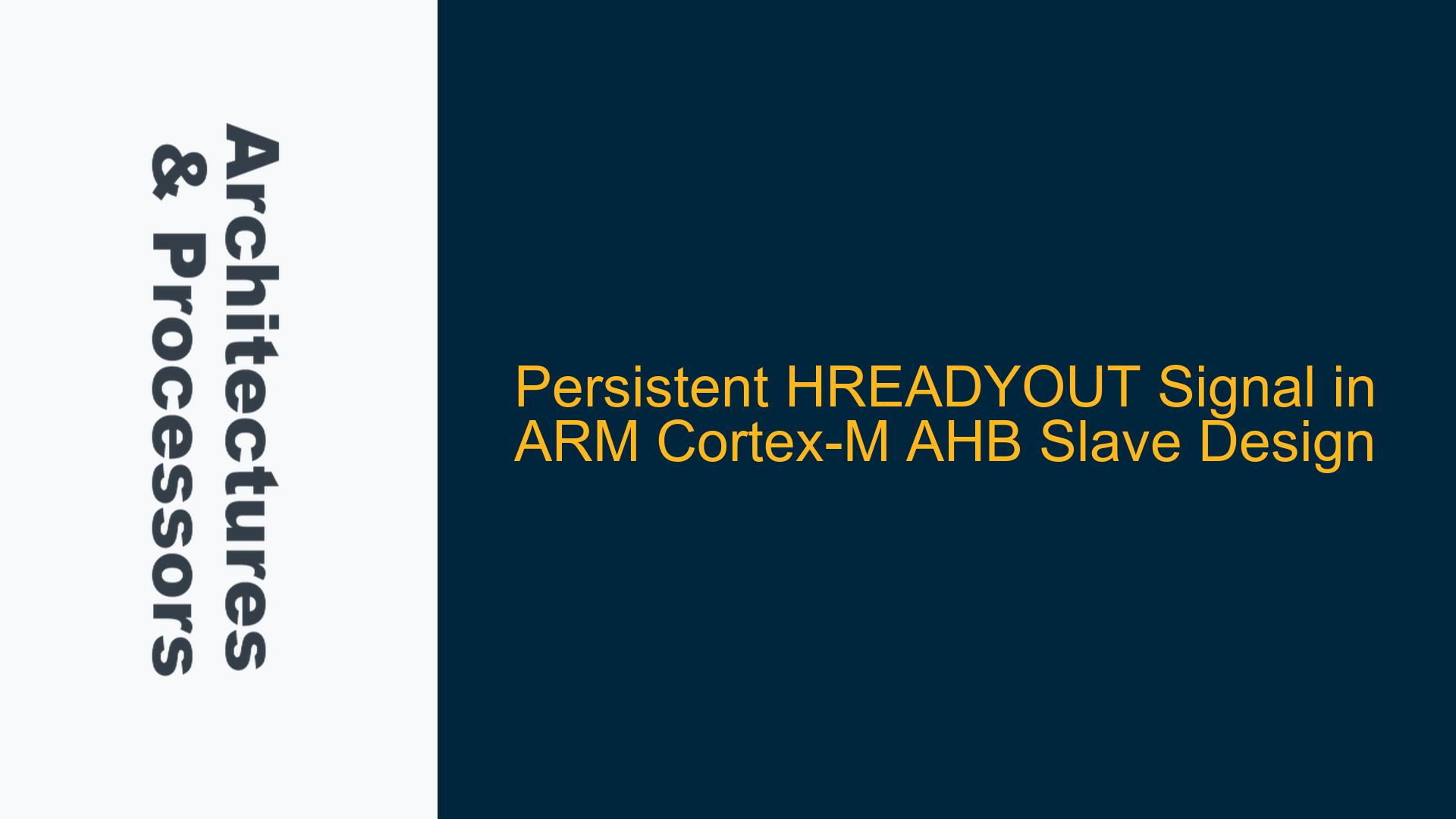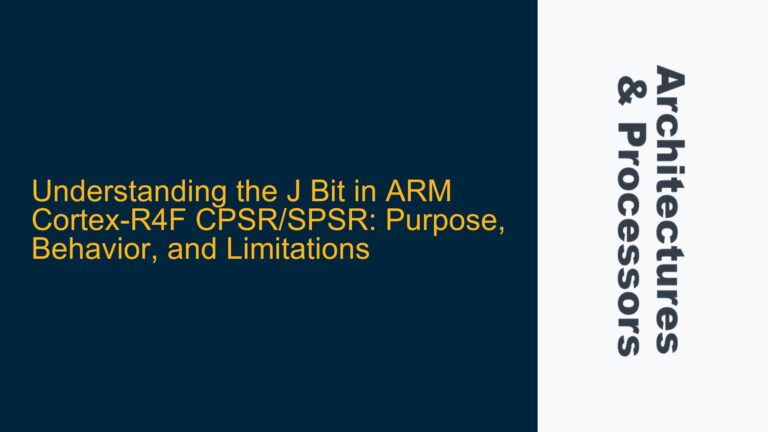Persistent HREADYOUT Signal in AHB Slave Modules
In ARM Cortex-M based System-on-Chip (SoC) designs utilizing the Advanced High-performance Bus (AHB) protocol, a common observation is that the HREADYOUT signal from slave modules is often hardwired to a constant value of 1. This behavior can be perplexing, especially when attempting to monitor data transactions such as HWDATA (write data) and HRDATA (read data) during specific execution points. The HREADYOUT signal plays a critical role in AHB transactions, as it indicates whether the slave is ready to complete the current transfer. When HREADYOUT is tied high, it implies that the slave is always ready, which may not align with the expected behavior in more complex or latency-sensitive designs.
The core issue arises when designers attempt to capture precise read and write events on HRDATA and HWDATA but find that the HREADYOUT signal does not provide the necessary granularity to distinguish between valid and invalid data phases. This is particularly problematic when the slave module does not introduce wait states, as the HREADYOUT signal remains high throughout the transaction. This behavior can mask timing issues, such as data skew between the master and slave, or long timing paths that could affect the integrity of the data transfer.
To understand this issue in depth, it is essential to explore the AHB protocol’s timing requirements, the role of HREADYOUT, and the implications of tying it to a constant value. Additionally, we must examine the potential causes of this design choice and provide actionable solutions to address the challenges it presents.
Hardwired HREADYOUT and Its Implications on AHB Timing
The HREADYOUT signal is a critical component of the AHB protocol, as it governs the flow of data between the master and slave. When HREADYOUT is high, it indicates that the slave is ready to complete the current transfer, allowing the master to proceed with the next phase of the transaction. Conversely, when HREADYOUT is low, the slave signals that it requires additional time to complete the transfer, effectively introducing a wait state.
In many ARM Cortex-M Design Kits (CMSDK), the HREADYOUT signal is hardwired to 1 in the slave modules. This design choice simplifies the implementation by assuming that the slave can always complete transfers in a single cycle. However, this assumption may not hold true in all scenarios, particularly when dealing with high-frequency designs, long timing paths, or complex slave modules that require additional processing time.
The primary implication of a hardwired HREADYOUT signal is that it eliminates the possibility of introducing wait states, which can be problematic in several ways. First, it assumes that the slave can always meet the timing requirements of the AHB protocol, which may not be feasible in designs with significant propagation delays or clock skew. Second, it complicates the task of monitoring valid data phases, as the HREADYOUT signal does not provide any indication of when the data is actually ready.
This behavior is particularly evident in the waveform provided, where multiple HWDATA and HRDATA transactions occur without any corresponding changes in the HREADYOUT signal. This makes it difficult to determine the exact points at which the data is valid, as the HREADYOUT signal remains high throughout the transaction.
To address this issue, it is essential to understand the underlying causes of this design choice and explore potential solutions that allow for more precise monitoring of data transactions.
Causes of Hardwired HREADYOUT in AHB Slave Modules
The decision to hardwire the HREADYOUT signal to 1 in AHB slave modules is often driven by a combination of design simplicity and performance considerations. However, this approach can lead to unintended consequences, particularly in designs with stringent timing requirements or complex data paths. Below, we explore the primary causes of this design choice and its implications.
Simplification of Slave Module Design
One of the primary reasons for hardwiring HREADYOUT to 1 is to simplify the design of the slave module. By assuming that the slave can always complete transfers in a single cycle, designers can avoid the complexity of implementing logic to manage wait states. This approach is particularly common in basic or low-performance slave modules, where the additional overhead of wait state management is deemed unnecessary.
However, this simplification comes at the cost of reduced flexibility. In more complex designs, where the slave may require additional time to process requests, the lack of wait state support can lead to timing violations or data corruption. This is especially problematic in high-frequency designs, where even small delays can have a significant impact on system performance.
Assumption of Ideal Timing Conditions
Another factor contributing to the hardwiring of HREADYOUT is the assumption of ideal timing conditions. In many cases, designers assume that the propagation delays between the master and slave are negligible, allowing the slave to meet the timing requirements of the AHB protocol without introducing wait states. This assumption is often valid in low-frequency designs or when the master and slave are located in close proximity on the die.
However, in real-world designs, this assumption may not hold true. Factors such as clock skew, long routing paths, and process variations can introduce significant delays, making it difficult for the slave to meet the timing requirements. In such cases, the hardwired HREADYOUT signal can mask these timing issues, leading to unreliable data transfers.
Lack of Support for Complex Transactions
In some cases, the hardwiring of HREADYOUT is a result of the slave module’s limited support for complex AHB transactions. For example, slaves that do not support burst transfers or split transactions may not require the ability to introduce wait states. In these cases, tying HREADYOUT to 1 is a reasonable design choice, as it simplifies the implementation without compromising functionality.
However, this approach can become problematic when the slave is integrated into a more complex system, where it may be required to handle a wider range of transactions. In such scenarios, the lack of wait state support can limit the system’s overall performance and reliability.
Addressing Hardwired HREADYOUT and Monitoring AHB Transactions
To address the challenges posed by a hardwired HREADYOUT signal, designers must adopt a more nuanced approach to AHB slave design and verification. This involves implementing mechanisms to introduce wait states when necessary, as well as developing strategies to monitor valid data phases accurately. Below, we outline a series of steps and solutions to address these issues.
Implementing Wait State Support in Slave Modules
The most straightforward solution to the hardwired HREADYOUT issue is to modify the slave module to support wait states. This involves adding logic to control the HREADYOUT signal based on the slave’s internal state and the timing requirements of the AHB protocol. By allowing the slave to assert HREADYOUT low when additional time is needed, designers can ensure that data transfers are completed reliably, even in the presence of timing delays.
To implement wait state support, designers must first identify the conditions under which the slave requires additional time to complete a transfer. This may include scenarios such as accessing slow memory, performing complex calculations, or waiting for external inputs. Once these conditions are identified, the HREADYOUT signal can be driven accordingly, ensuring that the slave only signals readiness when the data is truly available.
Adding AHB-to-AHB Bridges for Timing Optimization
In cases where the slave module cannot be modified to support wait states, designers can introduce an AHB-to-AHB bridge between the master and slave. This bridge acts as an intermediary, breaking the long timing path and allowing for the insertion of wait states when necessary. By adding a bridge, designers can effectively decouple the timing requirements of the master and slave, ensuring that data transfers are completed reliably.
The AHB-to-AHB bridge can be configured to introduce a fixed number of wait states or to dynamically adjust the number of wait states based on the slave’s response. This approach provides greater flexibility in managing timing delays, while also simplifying the design of the slave module.
Monitoring Valid Data Phases Using HTRANS and HSEL
To accurately monitor valid data phases in the presence of a hardwired HREADYOUT signal, designers can leverage other signals in the AHB protocol, such as HTRANS (transfer type) and HSEL (slave select). These signals provide additional context about the current transaction, allowing designers to distinguish between valid and invalid data phases.
For example, the HTRANS signal indicates the type of transfer being performed (e.g., IDLE, BUSY, NONSEQ, SEQ), while the HSEL signal indicates which slave is currently selected. By monitoring these signals in conjunction with HWDATA and HRDATA, designers can identify the exact points at which data is valid, even when HREADYOUT is tied high.
Synchronizing HRDATA with Master Clock
In scenarios where there is significant skew between the master and slave clocks, designers can implement synchronization logic to ensure that HRDATA is sampled correctly by the master. This involves adding flip-flops to the HRDATA path, effectively delaying the data by one or more clock cycles to align it with the master’s clock.
While this approach introduces additional latency, it ensures that the data is sampled reliably, even in the presence of timing delays. Designers must carefully balance the trade-off between latency and timing margin, ensuring that the system meets its performance requirements.
Leveraging Simulation and Formal Verification
Finally, designers should leverage simulation and formal verification tools to validate the behavior of the AHB interface and identify potential timing issues. By simulating a wide range of scenarios, including worst-case timing conditions, designers can ensure that the system operates reliably under all conditions. Formal verification can be used to prove the correctness of the HREADYOUT logic, ensuring that wait states are introduced only when necessary.
In conclusion, the hardwiring of the HREADYOUT signal in AHB slave modules is a common design choice that can lead to challenges in monitoring and validating data transactions. By understanding the underlying causes of this behavior and implementing the solutions outlined above, designers can ensure that their AHB-based systems operate reliably and efficiently, even in the presence of timing delays and complex transactions.






